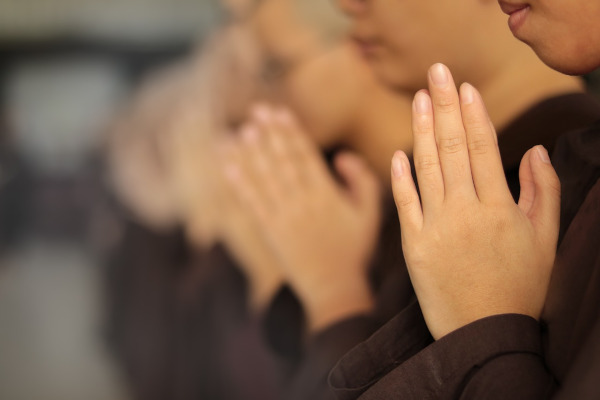Meditation, often painted with the brushstrokes of Eastern religions and shrouded in whispers of cultural appropriation, has become a practice shrouded in misconceptions. But what if we told you that meditation transcends cultural and religious boundaries, offering a universal journey of self-discovery open to all? Buckle up, dear friend, as we embark on a voyage to unveil the truth behind these common myths and demystify the essence of this transformative practice.
Misconception: Meditation is solely associated with Eastern religions.
For many, the image of meditation conjures up serene figures draped in saffron robes, chanting in hushed tones amidst incense-filled temples. While meditation certainly flourishes within Eastern religious traditions, it’s crucial to remember that this practice transcends cultural and religious boundaries. In fact, meditation’s essence – cultivating inner peace and self-awareness – resonates with individuals from all walks of life.
Think of meditation not as a religious ritual, but rather as a universal tool for self-discovery. Just like brushing your teeth or exercising, it’s a practice that anyone can incorporate into their routine, regardless of their beliefs or background. In this sense, meditation becomes a journey of inner exploration, offering insights and benefits that enrich lives irrespective of one’s faith.
But what about those seeking a non-religious approach? This is where the beauty of secular meditation practices comes in. Techniques like mindfulness meditation guide practitioners towards present-moment awareness without any religious connotations. Similarly, transcendental meditation (TM) focuses on effortlessly transcending thoughts to access a state of inner calm, again, free from any specific religious framework.
Now, this isn’t to say that meditation can’t complement and enhance existing spiritual beliefs. For many, the practice deepens their connection to their faith, providing a space for reflection and personal growth within their chosen tradition. Ultimately, how you choose to integrate meditation into your life is a deeply personal decision.
Remember, the key takeaway is this: meditation isn’t about subscribing to a specific belief system, but about unlocking the potential within your own mind and spirit. So, ditch the stereotypes and embrace this powerful tool for inner transformation, no matter where your life’s journey may lead.
| Meditation Practices Across Cultures | |||
| Culture | Practice | Key Principle | Potential Benefits |
| India | Mindfulness meditation | Present-moment awareness | Reduced stress, increased focus |
| Japan | Zen meditation | Sitting meditation with focus on breath | Improved calmness, emotional regulation |
| China | Qigong | Combining movement and breathwork | Enhanced balance, vitality, and energy |
| Indigenous North America | Vision quests | Connection to nature and spirit guides | Spiritual growth, self-discovery |
Related reading: Addressing 10 Common Myths about Meditation – Opens in new tab
Misconception: Cultural appropriation concerns in meditation practices.
As mindfulness practices gain mainstream popularity, concerns surrounding cultural appropriation in meditation become increasingly nuanced. It’s true that many meditation techniques have deep roots in specific cultural and religious traditions. Respecting these origins is crucial to ensure we engage with these practices authentically and ethically.
So, how can we navigate this ethical landscape? The key lies in approaching diverse meditation techniques with cultural sensitivity and awareness. This doesn’t require subscribing to a specific belief system, but rather acknowledging the historical and cultural context that shapes each practice.
Instead of blindly adopting practices out of context, let’s explore the rich tapestry of meditation offered by different cultures:
- Mindfulness meditation, with its roots in Buddhist traditions, emphasizes present-moment awareness and acceptance.
- Yoga Nidra, a guided relaxation technique originating in ancient India, encourages deep mental and physical rest.
- Transcendental Meditation (TM), developed by Maharishi Mahesh Yogi, uses a mantra to effortlessly transcend thoughts and access inner peace.
- Indigenous meditation practices, like those found in Native American and Australian Aboriginal cultures, often connect practitioners to nature and their ancestral lineages.
Remember, the beauty of meditation lies in its diversity. There’s no one-size-fits-all approach. Instead, explore different techniques with an open mind, seeking guidance from qualified teachers who respect and honor the origins of each practice. Choose the techniques that resonate with you personally, aligning with your own values and cultural context.

Misconception: Meditation conflicts with certain religious beliefs.
For some, the question arises: “Can I meditate while holding on to my religious beliefs?” This concern often stems from misconceptions about meditation being inherently religious or conflicting with existing faith practices. Let’s dispel those myths and explore how meditation can co-exist harmoniously with your convictions.
It’s true that certain meditation practices have religious origins, but it’s crucial to remember that meditation itself is not inherently religious. The core principles of mindfulness, self-awareness, and inner peace are universally applicable, transcending specific belief systems.
So, if you have concerns about potential conflicts, the good news is you have options:
1. Embrace Secular Techniques: Several meditation practices, like mindfulness meditation and transcendental meditation, are entirely secular and free from any religious connotations. These techniques focus on cultivating focus, relaxation, and self-awareness without engaging with any specific religious ideas.
2. Adapt Existing Practices: If you practice a particular religion, explore how you can adapt existing meditation techniques to align with your values and beliefs. For example, you can substitute religious mantras with affirmations or prayers that resonate with your faith. Remember, the essence of meditation lies in the inner experience, not the specific technique.
3. Seek Guidance from Religious Leaders: Many religious communities incorporate meditation practices into their traditions. Talk to your religious leader about their perspective on meditation and explore specific techniques that complement your faith journey.
Ultimately, the choice of how you integrate meditation into your life is deeply personal. Remember, meditation is not about subscribing to a specific dogma, but about fostering inner peace and self-discovery.
| Integrating Meditation with Different Faiths | |
| Religion | Example Adaptation |
| Christianity | Use prayer phrases as mantras in mindfulness meditation. |
| Buddhism | Integrate mindfulness techniques into existing meditation practices. |
| Islam | Combine mindful breathing exercises with dhikr (remembrance of God). |
| Judaism | Use guided meditations focused on gratitude and compassion. |
Related reading: Guide to Different Types of Meditation Practices – Opens in new tab
Misconception: Meditation requires specific physical postures or clothing associated only with certain cultural or religious traditions.
Ah, the image of meditation: cross-legged figures draped in flowing robes, perched serenely on meditation cushions. While specific postures and clothing play a role in certain cultural and religious traditions, let’s bust the myth: there’s no one-size-fits-all dress code for inner peace.
The beauty of meditation lies in its flexibility. Whether you picture yourself sitting on a zafu cushion, reclining comfortably on a sofa, or even taking a mindful walk in nature, the key is to choose a position that allows you to be comfortable and alert. Discomfort becomes a distraction, hindering rather than aiding your journey inward.
The same goes for clothing. Sure, loose, breathable fabrics might feel ideal, but ultimately, wear whatever makes you feel relaxed and undistracted. Ditch the pressure to replicate specific attire and prioritize personal comfort. Remember, meditation isn’t about outward appearances; it’s about cultivating stillness and awareness within.
Here’s the kicker: adapting meditation to your unique needs is not only acceptable but encouraged! Experiment with different postures, explore various meditation techniques and discover what works best for you. It’s your journey, your comfort zone, your inner peace to cultivate.
So, the next time you picture meditation, remember: ditch the rigid expectations and embrace the freedom. Find a position and attire that lets you settle into your practice, free from discomfort and distraction. After all, true calmness starts from within, not with what you wear or where you sit.

Misconception: Meditation makes you passive or emotionless.
Ah, the misconception that meditation turns you into a stoic, emotionless robot. Let’s clear the air – meditation isn’t about suppressing emotions, it’s about becoming more aware of them and learning to manage them effectively. Think of it like training your emotional gym: through practice, you gain strength, flexibility, and better control over your inner world.
Here’s how meditation actually enhances your emotional life:
1. Sharpened Awareness: Meditation hones your ability to observe your emotions without judgment. Instead of being swept away by a wave of anger or anxiety, you learn to recognize it as it arises, acknowledging its presence without getting entangled in its story.
2. Increased Regulation: As you become more aware, you gain the power to choose your response instead of reacting impulsively. Meditation equips you with tools to soothe anxious thoughts, calm racing emotions, and navigate challenging feelings with greater ease.
3. Deeper Understanding: Through consistent practice, you start to understand the root causes of your emotions. Why do you get triggered by certain situations? What deeper needs might be driving your reactions? This self-awareness empowers you to address the core issues, leading to lasting emotional well-being.
4. Cultivating Compassion: Contrary to popular belief, meditation fosters greater compassion, not just for yourself but for others too. As you develop emotional intelligence through your practice, you become more attuned to the emotions of others, fostering empathy and understanding.
So, if you’re worried about meditation making you emotionless, rest assured – it’s quite the opposite! It’s a journey towards embracing your full emotional spectrum with awareness, understanding, and the ability to navigate them with grace and resilience.
A meta-analysis published in “JAMA Internal Medicine” (Goyal et al., 2014) suggests that mindfulness meditation interventions can significantly reduce symptoms of anxiety and depression, indicating an active engagement with emotions rather than suppression.
End Words
Meditation, at its core, is not about subscribing to a specific belief system. It’s a tool for cultivating inner peace and mindfulness, accessible to anyone willing to embark on the exploration. From secular mindfulness techniques to practices nestled within various religious traditions, meditation offers a spectrum of options to color your journey. It’s not about shedding your identity, but rather weaving meditation into the tapestry of your existing beliefs, enhancing them without erasing their unique hue.
So, let’s shed the “religious only” label and embrace the boundless potential of meditation as a path for self-discovery, open to any soul seeking inner exploration. Stay tuned as we delve deeper, untangling further misconceptions and unveiling the diverse landscape of meditation practices waiting to be explored.
Do you want to learn more about Meditation? Check out our recommendations at “Meditation Bookshelf” and many free resources at our “Free MeditationLibrary“ – Opens in new tab
Resources
- Sun S, Goldberg SB, Loucks EB, Brewer JA. Mindfulness-based interventions among people of color: A systematic review and meta-analysis. Psychother Res. 2022 Mar;32(3):277-290. doi: 10.1080/10503307.2021.1937369. Epub 2021 Jun 7. PMID: 34098859; PMCID: PMC8648858.
- Mindfulness Has Parallels to Indigenous Cultural Practices (2022).
- Mindfulness and Modern Mindfulness: Considering Buddhist Communities and Personal Salvation from Depression, by Brian D. Somers
- Mindfulness-based interventions and their effects on emotional clarity: A systematic review and meta-analysis. David Cooper, Keong Yap, Luisa Batalha (2018) DOI:10.1016/j.jad.2018.04.018
Stay in Touch
 Join our newsletter by using the forms on this website or click here!
Join our newsletter by using the forms on this website or click here! Follow us on Google News
Follow us on Google News Follow us on Facebook
Follow us on Facebook
Featured Image by Gerd Altmann from Pixabay






